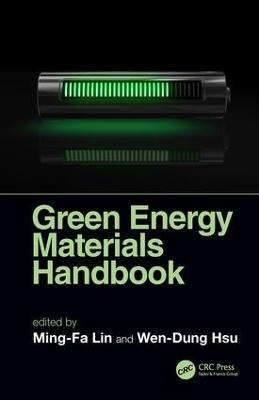
Green Energy Materials Handbook
CRC Press (Verlag)
978-1-138-60591-6 (ISBN)
Green Energy Materials Handbook gives a systematic review of the development of reliable, low-cost, and high-performance green energy materials, covering mainstream computational and experimental studies as well as comprehensive literature on green energy materials, computational methods, experimental fabrication and characterization techniques, and recent progress in the field.
This work presents complete experimental measurements and computational results as well as potential applications. Among green technologies, electrochemical and energy storage technologies are considered as the most practicable, environmentally friendly, and workable to make full use of renewable energy sources. This text includes 11 chapters on the field, devoted to 4 important topical areas: computational material design, energy conversion, ion transport, and electrode materials.
This handbook is aimed at engineers, researchers, and those who work in the fields of materials science, chemistry, and physics. The systematic studies proposed in this book can greatly promote the basic and applied sciences.
Ming-Fa Lin is a distinguished professor in the Department of Physics, National Cheng Kung University, Taiwan. He received his PhD in physics in 1993 from the National Tsing-Hua University, Taiwan. His main scientific interests focus on essential properties of carbon-related materials and low-dimensional systems. He is a member of American Physical Society, American Chemical Society, and Physical Society of Republic of China (Taiwan). Wen-Dung Su is Associate Professor, Department of Materials Science, National Cheng Kung University, Taiwan. Dr. Su received a PhD from University of Florida and was awarded Outstanding Teaching Award, Institute of Engineering Education, Taiwan.
Introduction
Molecular effects of functional polymer binders on Li+ transport on the cathode surface within lithium ion battery
2.1 Introduction
2.2 Molecular dynamics simulation details
2.3 Results and discussion
2.4 Summary and future perspectives
Essential properties of Li/Li+ graphite intercalation compounds
3.1 Introduction
3.2 The theoretical model
3.3 Rich geometric structures of graphites and graphite intercalation compounds
3.4 Unusual band structures of graphite-related systems
3.5 van Hove singularities in density of states
3.6 Chemical bondings and charge distributions
3.7 Summary
Defective and amorphous graphene as anode materials for Li-ion batteries: a first-principles study
4.1 Introduction
4.2 Computational methods
4.3 Results and discussions
4.4 Conclusion
Rich Essential Properties of Si-Doped Graphene
5.1 Introduction
5.2 Computational methods
5.3 Geometric structures of Si-adsorbed and Si-substituted graphene
5.4 Rich electronic structures
5.5 Spatial charge densities
5.6 The diverse density of states
5.7 Summary
Diversified essential properties in transition metals adsorbed Graphene
6.1 Introduction
6.2 The theoretical model
6.3 Results and discussions
6.4 Summary
Combining neural network with first-principles calculations for computational screening of electrolyte additives in lithium ion batteries
7.1 Introduction
7.2 Materials and methods
7.3 Results and disscussions
7.4 Conclusion
Metal oxide-reduced graphene oxide (MO-RGO) nanocomposite as high performance anode materials in Lithium ion batteries
8.1 Introduction
8.2 Potential binary metal oxides asanode materials in LIBs
8.3 Complex metal oxides as anode materials in LIBs
8.4 Metal oxide-graphene/reduced graphene oxide nanocomposite as anode materials in LIBs
8.5 Our research contribution toward LIB
8.6 Conclusions
In-situ X-ray and Neutron Analysis Techniques on Lithium/Sodium ion batteries
9.1 Introduction
9.2 Methodology for in-situ X-ray and neutron scattering experiments
9.3 In-situ X-ray analysis on synergistic effects of Si anode materials
9.4 In-operando X-ray diffraction - a quantitative analysis on Si-graphite negative electrode
9.5 In-situ X-ray diffraction analysis of lithiation-induced crystal restructuring of Sn/TiO2 nanocrystallites
9.6 In-operando neutron diffraction analysis on low temperature lithium diffusion behaviors in 18650 Li-ion battery
9.7 In-operando neutron diffraction Studies on P2-Na2/3Fe1/3Mn2/3O2 cathode in a sodium ion battery
9.8 Summary
Micro-Phase Separated poly(VdF-co-HFP)/Ionic Liquid/Carbonate as Gel Polymer Electrolytes for Lithium-Ion Batteries
10.1 Introduction
10.2 Experimental
10.3 Results and discussion
10.4 Conclusion
Gel and solid electrolytes for Lithium ion batteries
11.1 Introduction
11.2 Solid-state electrolytes (SSEs)
11.3 Gel Polymer Electrolytes (GPEs)
11.4 Summary
Silicon-Nanowire Based Hybrid Solar Cells
12.1 Introduction
12.2 Silicon nanowires fabrication
12.3 PEDOT: PSS polymer as the p-type layer of hybrid solar cell application
12.4 Silicon Nanowire based Hybrid Solar Cells
12.5 Conclusion
Characterization and Performance of Li-ZnO Nanofiber and Nanoforest Photoanodes for Dye-sensitized Solar Cell
13.1 Introduction
13.2 Experimental
13.3 Results and discussion
13.4 Conclusion
Review of monolithic dye-sensitized solar cells and perovskite solar cells
14.1 Introduction
14.2 Monolithic dye-sensitized solar cells
Mesoporous electrode for monolithic perovskite solar cells
Conclusion
15. High-Performance Quasi-Solid-State Polymer Electrolytes for Dye-Sensitized Solar Cell Applications
16. Concluding Remarks
17. Perspective on Battery Research
Index
| Erscheinungsdatum | 24.06.2019 |
|---|---|
| Zusatzinfo | 27 Tables, black and white; 142 Illustrations, color; 36 Illustrations, black and white |
| Verlagsort | London |
| Sprache | englisch |
| Maße | 156 x 234 mm |
| Gewicht | 1780 g |
| Themenwelt | Naturwissenschaften ► Chemie ► Physikalische Chemie |
| Technik ► Elektrotechnik / Energietechnik | |
| Technik ► Maschinenbau | |
| Technik ► Umwelttechnik / Biotechnologie | |
| ISBN-10 | 1-138-60591-3 / 1138605913 |
| ISBN-13 | 978-1-138-60591-6 / 9781138605916 |
| Zustand | Neuware |
| Haben Sie eine Frage zum Produkt? |
aus dem Bereich


